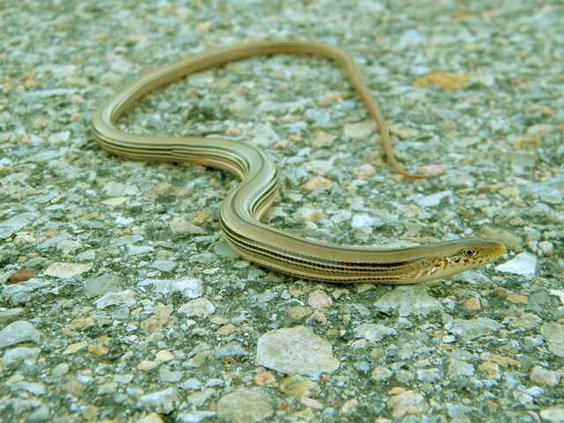The most obvious difference between lizards and snakes is usually the presence or absence of limbs. However, there are always exceptions. In Kansas, that exception is the Western Slender Glass Lizard (Ophisaurus attenuatus). There are currently 16 lizard species documented in Kansas. The Western Slender Glass Lizard is not only the largest lizard species in Kansas, it is also the only lizard in the state that doesn’t have limbs! The Western Slender Glass Lizard is commonly mistaken for a snake because of its lack of limbs. However, like all lizards, the Western Slender Glass Lizard has external ear openings and eyelids, whereas snakes lack both. The range of the Western Slender Glass Lizard in Kansas expands throughout the eastern two-thirds of the state. The Western Slender Glass Lizard prefers prairies and woodlands, but to increase your chances of seeing this lizard, focus your searches around tall grass along woodland edge. The Western Slender Glass Lizard is a burrowing species, but spends most of the day foraging on the surface. If you do manage to see one, capturing it can be very difficult because they slither really fast. If you are successful in capturing one, handle it with care because, like most lizards, the Western Slender Glass Lizard tends to break its tail off when captured to make a quick escape. In fact, the Western Slender Glass Lizard has a higher tendency to break its tail off than most lizard species when captured, hence the “Glass” in its name.
To learn more about the Western Slender Glass Lizard and other Kansas reptiles, I recommend the following readings:
•Collins, J.T., Collins, S.L., and Taggart, T.W. 2010. Amphibians, Reptiles, and Turtles in Kansas. Eagle Mountain Publishing, LC, Eagle Mountain, Utah. xvi + 312 pp.
•Collins, J.T., Collins, S.L., and Taggart, T.W. 2011. Amphibians, Reptiles, and Turtles of the Cimarron National Grassland, Kansas. Second (Revised) Edition. U.S. Forest Service, Elkhart, Kansas. viii + 68 pp.
•Conant, R. and Collins, J.T. 1998. Peterson Field Guide to Reptiles and Amphibians of Eastern and Central North America. Third Edition Expanded. Houghton Mifflin Company, Boston. xviii + 616 pp.
Also, visit the Kansas Herpetofaunal Atlas (http://webcat.fhsu.edu/ksfauna/herps/).
Dr. Dan Witt is a retired physician and avid outdoorsmen.
MARSH MUSINGS





